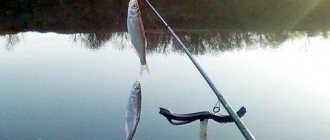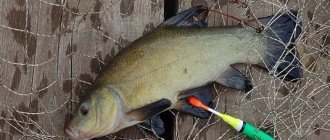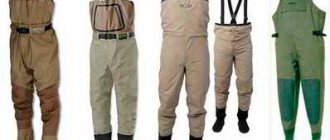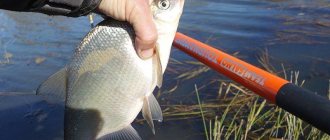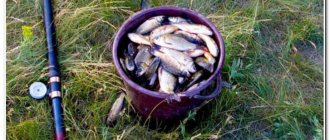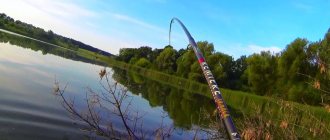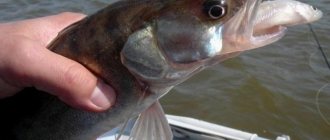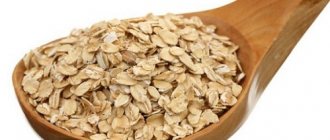Home > Winter fishing > Catching dace in winter - fishing features
Dace is quite common in freshwater bodies of water from Europe to Siberia. The weight of European dace rarely exceeds 200 grams, and Siberian dace - 400, but despite its modest size, it is a fairly popular object of fishing. With the right approach, catching dace in winter can provide the angler with a large amount of this small but very tasty fish.
Selection of gear
Given the very modest size of the prey, the gear chosen is very light and thin. 1. Fishing rod – absolutely any one suitable for winter fishing. Small “balalaikas”, already equipped with a coil, are very convenient.
2. Nod – lavsan, high sensitivity. The dace's bite is very light and weak, so a hard nod simply will not allow it to be noticed.
3. Fishing line – monofilament, with a diameter of 0.06-0.08 mm. You can put it thicker, but there won’t be much benefit. An even better option is to use fluorocarbon thread, which is invisible in the water, but the high price puts it out of reach for many anglers.
Basically, dace fishing in winter is done with a nodding fishing rod with a jig, but a float rig is also suitable. In this case, you should add a small weight to the tackle set.
4. Hooks No. 2.5-3 according to the domestic size chart. The float is selected to match the total weight of the equipment. The weight is tied at the end of the fishing line, and the leash with a hook is attached a little higher. The distance to the weight and the length of the leash may vary and are selected according to the fishing conditions.
Fishing methods
You can catch dace in winter throughout the daylight hours; biting activity is observed in the morning. At the end of winter, fish are also fished at night. The fish bite best in December and February. In winter, dace are caught using a float rod and jig. Fishing with a jig with bloodworm bait is more effective.
In December, you should actively play with bait, thereby attracting fish. Some fishermen fish with a reelless bait, but such bait requires experience and is used for professional fishing. During winter fishing, dace behaves cautiously.
The fish is afraid of noise; after drilling a hole, you need to wait a while for the individuals to return.
Gear used
The float equipment is formed so that the current does not pull the float down. In this case, the diameter of the fishing line is of great importance. Since the weight of dace is no more than 150 g, you need to use high-quality thread with a thickness of 0.08 mm. Then the float can be close to the surface of the river.
To create the lower rig, a sinker is attached to the end of the thread, and a leash is attached to the thread 20 cm above it; with the bait attached to the hook, it will move from one side to the other, luring the dace.
A fishing rod for dace should have a nod and a jig. In this case, the sensitivity of the nod should correspond to the strength of the river current and the mass of the jig. Fishing with jigs can be active or passive. During active fishing, the rod is held in the hand, and the jig is used to retrieve it so that it bounces and moves.
If the weight of the jig is small and it is carried to the bottom, then you need to lower the tackle a little down and pull with stops. Periodically, the jig needs to be stopped for a longer period; the bite occurs at this time.
If fishing is passive, then the rod is placed on the ice so that the nod, bent under the weight of the jig, is above the hole.
Periodically, the nod needs to be moved, this will cause the bait on the hook to move. In the depths of winter, use dim jigs that can withstand strong currents. The fisherman must prepare several jigs of different colors and shapes in advance; this will allow him to quickly achieve a good bite from active fish.
You can use combined gear. A nod is installed on the rod, which becomes an indicator of the bite, and a float rig with a sinker is attached to the fishing line. Most often, fishermen use an 18 hook with a long shank; its color is selected depending on the shade of the bait.
Choosing a jig and equipment features

Jigs for dace are selected in a small size so that the hook is no larger than the third number. 1. Basic models: – ant; – pellet; - lentils; – larva; – rhombus; - the devil and others. 2. Color. Depends on fishing conditions - water color, weather, etc. They mainly use baits of not too bright colors - silver or lead. But jigs of copper, yellow and lemon colors are also considered catchy.
3. Material. Most often, dace fishing in winter occurs on rivers with fairly fast currents. In such cases, the heaviest tungsten baits that can withstand the flow of water are used. When installing two jigs at the same time, lead models are used, which weigh each other down enough.
The catchability of jigs can be easily increased by attaching yellow, red or white beads to the hook. In cloudy weather, it is good to use luminous baits with a drop of phosphorus.
In any case, when you go fishing for dace, you should stock up on a sufficiently large number of jigs of different models and colors in order to select the most catchy one during the fishing process. Often fishermen use not one, but two or more jigs. They are knitted directly on the main line at a distance of 20-30 cm from each other. For this, it is good to use stop beads - during fishing, the gap between the baits can be easily changed, which can lead to an increase in bites.
How to prepare bait for dace
To add to your page you need to register or log in.
DIY bait for winter fishing - recipes for different types of fish
For smaller specimens, it is necessary to create a voluminous feeding spot in the water column, and for larger specimens, denser bait is used, which creates a feeding spot at the bottom of the reservoir.
In addition, dace is found in almost all of Europe, both northern and southern - in Sweden, Germany, Austria, France and Italy. We always used ready-made bait.
The mixture should be plant-based rolled oats, pearl barley, wheat with the inclusion of cake and bloodworms. You can make this type of fertilizing right on the pond...
Glyceria
So, the most common bait for dace, which is quite effective, is ordinary white bread. There is no magic recipe. It’s just that as a result of casting, the spoon did not fall close enough to the fish or something didn’t like it.
Moreover, there should be even less nutrients than the same clay or soil. Tips Here are some useful tips that will help increase the effectiveness of bait and also save money.
I didn’t know it was so easy to make them yourself….
Virinea
How to catch dace in winter
- Bait for dace: the best DIY bait options
How to prepare bait for dace - how to catch dace in winter
Fish should not be overfed. Before use, it should be soaked, after which a dough-like porridge from it is applied to stones, which are then thrown into the water. Combine all this and mix, and then add pea porridge.
Personally, I stopped at St. There is no doubt that this article will help many novice anglers in mastering tactics and strategy when fishing for dace. In Russia, it is most numerous in the middle and northern provinces, and is less common in the south.
To a depth of up to 3 meters...
Beatrice
To minimize the amount of bait, you need to add raw clay to the mixture. But in large bodies of water it may well please the fisherman.
Dace loves fresh, clean water and therefore is more often found in small and medium-sized rivers than in large rivers; in places, such as beyond the Urals, it is quite common in flowing lakes with a sandy or gristly bottom; In stagnant lakes and dug ponds, dace is never caught, and in general it avoids silt and warm water, which is why it is rarely found in river bays. Pheromone-based lures. Upon arrival at a reservoir, such a dry mixture is mixed with soil and water from this reservoir. Take one pack of seeds per loaf of bread...
Elizabeth
In clear water, it is not difficult to see from a bridge or dam that dace stay not at the bottom or near the surface, but in the water column, but quickly rush up or down for food. In addition to them, vanillin, roasted seeds, cocoa powder and milk powder are added to the mixture. Flavorings should be added to a minimum.
Sometimes when catching chub or ide with a grasshopper, especially if the bait is small, you can catch a record-breaking dace that looks like it weighs half a kilo. They are left dry and upon arrival at the reservoir, mixed with clay and water added. Read the relevant manuals for a specific type of gear on the pages of my website.
Depending on the consistency and ingredients included in the bait, you can attract either small or large roach...
Martha
To make winter feeding for bream you need: Winter fishing is also not complete without feeding fishing points. After all, bait always plays an important role when catching any fish, with the exception of predators, of course.
If fishing is carried out in reservoirs that are actively visited by fishermen, then it is better to introduce feed bloodworms and soil taken from the shore of the reservoir into the bait. The dace immediately reacts to bait thrown into the water, and it is of little interest to the composition of this bait.
That’s why I prefer to make my own baits. This composition has proven itself to be excellent:…
Vlasta
How to catch more fish? From my own experience I can say that for my conditions this is a very effective bait, with which I caught not only dace, but also perches and roaches.
One batch is without feeding, the second is purchased ready-made feeding for bream, the third batch is homemade feeding consisting only of crushed or breadcrumbs.
But, as you know, many fishing enthusiasts do their own research and create their own recipes, both simple and complex.
But if you choose the right moment, you can perfectly fish with a running basting or a running lift, fishing becomes even more entertaining and rewarding: Since fishing very often takes place on rivers with a rocky, catchy bottom, leads often break off; a thick main line protects against the loss of the rest of the equipment...
Ustinya
To those areas where remnants of algae remain. They are something like a rotating spoon, only instead of a petal there is a propeller. Fishermen soak it, then cover it with stones and throw it into the intended fishing spot.
Although, then the process of fishing itself will not be so interesting, which encourages the strong half of humanity to wake up in the early frosty morning and go with an ice ax at the ready into the snowy unknown distances, following their dreams.
It’s a pity that Rosprirodnadzor wants to impose a ban on its sale….
Bela
The bottom of the dace rivers is mostly sandy, partially silted, especially at the bends. Other fishermen grind fresh or bread in the form of crackers in a meat grinder along with seeds.
Before adding worms to complementary foods, it is a good idea to soak them in goose fat or camphor oil; Dry bait can be stored for a very long time. And therefore in winter it is easier to find it on a reservoir and, accordingly, to catch it too.
It would also be a good idea to add a little cocoa or milk powder to the mixture - dace is very responsive to such aromatic seasoning...
Wanda
Features of winter complementary feeding In winter, it is more difficult to choose complementary foods, due to the fact that the fish’s taste changes, it feeds less often and is more reluctant. For my conditions, the main thing is that the fishing line has a minimal effect on the flight of a light-weight bait and is as invisible as possible to the fish, since dace is still not a predatory fish and I think fluorescent-colored fishing lines will scare it away.
Contacts Bait for dace Bait is needed for catching almost all types of peaceful fish. Already directly while fishing, it is good to add bloodworms to the balls with complementary foods. In stagnant water, it can quickly scare away the fish, but without complementary food, the bream takes well.
But if you choose the right moment, you can fish perfectly with a running basting or a running lift, fishing becomes even more entertaining and rewarding:...
Beatrice
Source: https://www.inaf.rezkiykakponos.ru/wuzazylegy/50600.php
Features of using two jigs:
• The bottom bait is usually larger. In this case, the dace often grabs the top hook.
• If the current is too strong, then the lower jig is tungsten, and the upper one is lead. The first will play the role of a weight, and the second, lighter, will oscillate in the water flow, attracting dace.
• There is a dark-colored bait on the bottom (gray, black, brown), and a brighter one on top (yellow, white, red). The top bait is also decorated with bright beads or a drop of phosphorus.
• Both the same and different models can be used. From bottom to top: devil-devil, ant-shot, shot-larva and other combinations.
When catching dace with a jig, you will have to experiment, especially if the bite is weak. You shouldn’t rely on one piece of equipment, so it’s better to take several fishing rods, especially since dace also bites on stationary bait.
Fishing Features
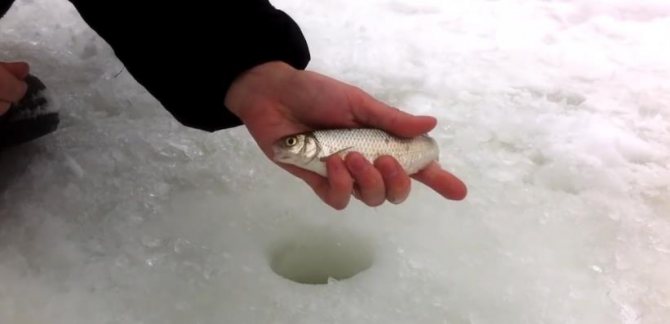
In winter, dace does not move very actively around the reservoir. Therefore, there are two fishing tactics:
1. Passive. In a certain place, several holes are drilled, which are baited and fished one by one. In this case, the fisherman’s main hope is in the right area and bait that can lure fish.
2. Active. Involves frequent movements on the ice with drilling new holes. This tactic, if a school of dace is found, can bring a fairly significant catch even without the use of bait.
When fishing with a jig, the angler must thoroughly master the gear. Too thin equipment and a flexible sensitive nod easily distort the movements of the bait, making them sharp and jerky, which will only scare away the cautious dace.
The game options are as follows:
1. The bait touches the bottom and with a smooth rise and descent, several careful taps are made on the ground. If the bottom is touched lightly enough, then a bite will occur at this point. The extra noise of the dace scares him.
2. The jig, swaying smoothly, rises 70-90 cm above the ground and falls without playing. The same method is suitable for fishing in the current, only the ascent and descent are performed without additional vibrations of the bait.
It is quite difficult to single out a specific tactic - you often need to improvise, choosing the appropriate game while fishing. The height of rises, pauses - all this can change in the absence or deterioration of the bite.
The dace's bite is very careful and if you gape, it's easy to miss it. A slight tilt or lift of the guard signals a bite. The hooking should be smooth and accurate - the dace has very delicate lips that can easily be torn off with a sharp jerk of the tackle. Dace are often caught using a standing bait - many anglers claim that this way the likelihood of bites is higher. To do this, the fishing rod is placed on a stand near the hole, while the nod is in a bent working position. A float can also be used as a signaling device.
Catching dace in winter. Bait selection
The main food of dace is various insects and their larvae. Particularly catchy baits:
– bloodworm; – maggot; – burdock moth larva; – bark beetle; - caddisfly.
At the same time, it will not be possible to choose the best bait - the preferences of the fish largely depend on the geography of the fishing location. Many consider bloodworms to be the best bait, but this may be due to the easy availability of these larvae.
“Bait sandwiches” have proven themselves quite well: maggot bloodworms; bloodworm-larva of burdock moth, etc., up to a foam ball and bloodworm. In some regions, catching dace in winter is done using a piece of lard and bloodworms.
Vegetable baits are also suitable as a complement to bloodworms: steamed pearl barley, semolina, dough.
It is possible that dace will also bite on an empty reelless jig - it all depends on the activity of the fish and the angler’s ability to play with the bait.
DIY bait for winter fishing
Winter fishing is radically different from summer fishing and quite often is a real test for many winter fishing enthusiasts. Not everyone is able to fish all day in the cold or in the presence of wind.
In addition, the weather can change for the worse at any moment. Therefore, warm clothes never hurt. For winter fishing to be effective, you need to:
Particular attention should be paid to the last point, where bait is indicated.
DIY bait recipes for winter fishing
Universal bait
Many similar types of bait have been invented. Here is the simplest recipe for homemade bait. It includes:
- Hercules.
- Cake (makuha).
- Breadcrumbs.
- Vanillin.
- Clay.
- Water.
You can prepare the composition directly on the pond; just combine all the ingredients together and mix them well. But we should not forget that it is winter outside and preparing bait at the fishing spot is not very easy if you need to deal with water.
After this, small balls are rolled out of such a mixture. That's all! You can begin the process of attracting fish. At the same time, it is worth noting the ready-made commercial bait “moth cloud”.
This bait contains bloodworms, hemp, cinnamon, mayfly, and betaine.
Bait for perch
Since perch is a predatory fish, the bait should be based on ingredients of animal origin. The following recipe works well:
- Filling in the form of clay, silt, breadcrumbs or biscuit.
- Bloodworm.
- Chopped worms.
- Amphipods.
All ingredients are mixed in equal proportions (two parts filler), after which balls with a diameter of 5-7 cm are rolled. Shrimp meat or dried blood can be added to the recipe. Scales also work well if you add them to the main recipe.
Bait for crucian carp
In small ponds and lakes, where there is a lack of oxygen in winter, crucian carp burrow into the silt and fall into a state of suspended animation. It is absolutely useless to catch crucian carp in such reservoirs in winter. As for large reservoirs, where oxygen reserves allow crucian carp to lead an active lifestyle even in winter, here they can please the fisherman with frequent bites.
Bait for crucian carp should be easy. At the same time, it should crumble before it reaches the bottom. There should be a minimum of ingredients of animal origin, otherwise predatory fish will do, which will scare off the crucian carp.
The simplest bait option for crucian carp:
- Breadcrumbs.
- Some bloodworms and chopped worms.
Bait for roach
In winter, roach leads an equally active lifestyle, therefore, you can always count on a roach catch. In this regard, many fishermen focus on the roach bite. Here is a simple bait recipe for catching roach:
- Filling (breadcrumbs) – 300-400 grams.
- Roasted sunflower seeds – 1 cup.
- Dried tangerine peel - 0.5 cups.
- 2 tbsp. spoons of flour.
All ingredients are mixed with the addition of water and mixed thoroughly.
Bait for bream
As a rule, water transparency increases greatly in winter, therefore, bait is needed that could create a cloudy column of food in the water.
Winter bait for bream can consist of:
- Filler, weighing about 1 kg (breadcrumbs).
- One glass of roasted sunflower seeds.
- Half a cup of oatmeal.
- One glass of split peas.
First of all, porridge is prepared from peas. To do this, add peas to boiling water. There should be 2 times more water than peas.
Cook over low heat with constant stirring until a homogeneous mass is formed. Then take breadcrumbs or regular crackers, but crushed, as well as crushed seeds and rolled oats.
Mix crackers, seeds and rolled oats together, then add pea porridge.
The consistency should be such that the balls form easily and just as easily they fall apart when pressed lightly. Before use, you can add bloodworms to the porridge.
Groundbait for dace
With the arrival of winter, dace gathers in numerous flocks and moves into deep holes, where it can remain until the first thaw. When the temperature begins to rise, the dace comes out into shallow water, where last year’s grass remains.
Dace is best caught during the first three weeks after the reservoir is covered with ice. During times of thaw, this fish can be caught all day, as well as at night. For a more effective catch, bait will not hurt either.
It can be prepared from:
- Vegetable base (wheat, pearl barley, rolled oats).
- Bloodworm.
- Cake (makuhi).
You can take store-bought bait briquettes, as they take a long time to dissolve in water and effectively attract dace.
Groundbait for bream
Bream is considered a bream, weighing up to 1 kg. Unlike older individuals, the bream is considered a schooling fish. In this regard, it is easier to catch white bream in a pond. But you shouldn’t count on a catch without bait. Although there are times when the bream bites even without bait.
Fishermen proceed as follows: they drill several holes right there, dividing them according to the fishing method.
One part is drilled without bait, the second part involves the use of purchased bait, the third part is designed for the use of homemade bait. After this, they begin fishing each hole separately.
If an active bite is observed in one of the parts of the holes, then this particular technology should be followed. And fishing technology is related to whether to feed the bream or not.
Top 5 baits for winter fishing
Everything related to the five best recipes for winter fishing should not be considered as ideal ones that can ensure fishing results. Unfortunately, everything is not so simple and each recipe requires individual application, based on fishing conditions.
Ready-made factory baits should be divided into:
- Winter bait Sensas 3000 Ready Roach;
- Greenfishing (Winter);
- DINAMITE BAITS Ice Ground Bait;
- Mondial-f Wintermix Bream Black;
- Winter baits ka.
Features of winter bait
Choosing bait in winter is much more difficult than in summer. This is due to the fact that in winter the behavior of fish changes due to a decrease in its activity.
All ingredients require careful grinding, and the use of flavorings should be kept to a minimum. The main task is to ensure the creation of bait turbidity.
As for taste, it should be moved to the background. Very often, for this purpose, cocoa or milk powder is added to the bait.
Some recommendations
Here you can find out some useful information that can increase the effectiveness of winter bait. Here they are:
- It is better to place worms that are planned to be added to bait in goose fat or camphor oil beforehand.
- As a rule, dry ingredients have a very long shelf life. You need to add water directly near the reservoir.
- In winter it is very difficult to get worms. Although it can be propagated at home.
- Amphipod crustaceans, including bloodworms, can be prepared in the summer. They can be stored either dried or frozen.
- In certain reservoirs where the depth is within 3 m, bait can be used in dry form. While the small particles are saturated with water, they will slowly sink to the bottom, which will certainly interest the fish.
Bottom line
No matter how universal bait is created, each angler has his own recipe, which takes into account both the individuality of the angler himself and the individuality of the reservoir. Although again, everything is purely relative.
Source: https://udilka.su/prikormki-dlja-zimnei-rybalki-svoimi-rukami.html
Using bait
Using bait when catching dace from ice is very useful. It consists of crushed plant ingredients with the addition of bait.
Main components:
– porridge; – bran; – purchased mixtures and briquettes; - food bloodworm.
The simplest option is frozen bloodworms, pieces of which are thrown into the hole. It slowly thaws in the water, not only attracting, but also holding the fish at one point. Store-bought vegetable briquettes work the same way.
The crumbly mixture should be made into small balls with the addition of small bloodworms (at least 15%) of a consistency that allows them to reach the bottom and gradually crumble, spreading a fragrant trail.
When fishing in the current, you should use a heavy bait feeder. Its weight depends on the strength of the current - the feeder should remain in place, allowing the water to gradually wash out the bait mixture. If the weight is insufficient, it can be easily weighted with a lead plate.
Do you need bait?
When fishing for dace in winter, you need to use bait, this allows you to lure the fish to one place. Bait is sold in stores; you need to add water and bloodworms to it. It should be written on the packaging that the composition is intended for winter fishing.
Pieces of food should be gradually washed away by water, otherwise you can overfeed the fish. Fishermen also use homemade bait prepared at home. For bait you need to use crackers, millet porridge, milk, egg powder and about 15% of the total amount of animal food: chopped worms, bloodworms.
There is no need to add flavorings because they may scare away the dace.
The bait should be placed in a feeder or simply used in the form of balls. Bait in the current should be weighted with small stones. Bait should be done before fishing, for this you use one feeder or two balls of the finished mixture. Then, once every half hour, feed the fish with 1 ball of the composition.
Searching for dace on a pond

On a familiar body of water, finding dace under the ice will not be difficult - he tries to stick to the same places. Particularly attractive to it are areas with a hard sandy or rocky bottom and a current.
At the beginning of winter, it is not difficult to find it - schools often stay at shallow depths of up to 3 meters and actively feed. The same thing happens at the end of winter - beginning of spring, when the dace begins its pre-spawning feast.
In the dead of winter, fish stay in places rich in oxygen:
• rifts; • boundaries of standing water and currents; • rapids.
It spends most of the winter day at depth, emerging from the pits only to feed. The exception is thaws - on such days, schools of dace can even rise into shallow water in search of food. As the ice begins to melt, large dace can be found in rivers near sand spits and islands.
Depending on the weather, the depth of the dace's parking and feeding areas may vary. If there are no severe frosts, then the search should begin from shallow depths, gradually lowering the bait lower and lower.
Let's start by finding fish
Like many other species that live in small rivers, dace loves clean water, so you need to look for it closer to the stream, or in pools with a reverse flow, where microorganisms, plankton and other goodies accumulate. It also makes sense to look for spruce on the border of underwater vegetation. In places without a current, in bushes close to the shore, bites will be much less frequent, and the specimens you will find, to put it mildly, are not trophy - it has been experimentally found that the largest individuals try to stay close to the stream.

Dace is not a bottom-dwelling fish; most often it stands halfway in the water, but when catching it, we still examine all horizons, from tapping on the bottom to practically lifting the bait into the hole. It is not uncommon for a fish to take bait right next to the ice. But sometimes, especially in the frosty depths of winter, when the fish are completely inactive, dace is caught only by the sluggish swaying of the jig at the very bottom.
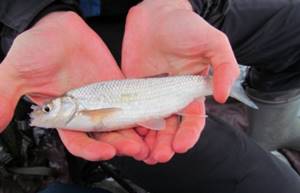
Useful tips for increasing your catch:
• The best time to catch dace is morning. An exception may be days when the wind blows from the southwest - biting activity may increase in the evening and last all night. • If there is no bite while playing with a jig, you can try to change the fishing horizon by raising the bait 1-1.5 meters from the bottom level, and continue playing at this height. • The dace very carefully takes the bait, trying to pull it off the hook, so empty hooks often occur. It is better to wait a little while the fish tastes and swallows the bait, waiting for a clear movement of the nod up or down, and then hook. • Catching dace in winter with a jig can provoke larger fish to bite. You need to be prepared for such a situation and not break the thin line in a hurry when hooking and retrieving. • The dace is very careful and, having been pricked by the sting of a hook, will immediately drop the bait. Therefore, the main thing is not to miss the bite.
Despite the fact that dace does not reach large sizes, its gastronomic qualities are very high. But this is not the only thing that attracts anglers. Catching dace in winter is a great way to practice using tackle, try out new baits and baits, and just have a good time in nature.
Bait and groundbait

For bait I use maggots, earthworms, and caddis flies.
There are never any problems with maggots and worms; they can be purchased at a fishing store if necessary. But you have to catch the caddisfly yourself. But it's worth it. Dace has great respect for mayfly larvae. A bulky light rag is lowered onto the shallow rocky bottom with the current and checked periodically. We remove the crawling caddis flies and everything starts again. Walking with a clothespin on a stick is somehow uncomfortable.
I’ll be honest - I rarely use bait, and then only when I have to fish from a hole. Rusks ground in a meat grinder with fried seeds, “chicken” porridge with the rare addition of bloodworms. I know that many fishermen specifically buy various baits and fragrant oils in the store.
But judging by the fact that the bite is not particularly different from mine (and I prefer baitless jigs), I believe that it’s not worth spending extra money on.
And now about the gear . I use a 5 meter long rod. Simple, Chinese. With a plastic inertial reel and a wound monofilament line with a diameter of 0.22-0.25 millimeters. This is regardless of how I fish - with a donk or a float. The most important thing is to set the stage itself with hooks and sinkers.
